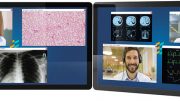Advanced ICU Care’s Chief Medical Officer S. Ram Srinivasan, MD, speaks to key topics concerning healthcare providers in the ICU today.
+ You’ve practiced medicine both in a telemedicine environment and at the bedside. How are these experiences different and how are they surprisingly the same?
In my experience, the two diverse roles – bedside team and telemedicine provider – are identical in the way that is most important: both are focused on caring for critically ill patients and helping them get well. The working environment of each and the physician’s proximity to the patient are significantly different but the work of the care team in each location is absolutely focused on collaborating on care and improving outcomes.
The bedside role is a more familiar one for most of us, as it is typically the focus and context of all of a physician’s training. Doctors become providers when they learn to provide care in physical interaction with a patient. The bedside role is also more physically demanding, as the running from bed to bed and the steady pace of procedures can take a physical toll on you. It can also be difficult to leave the hospital at the end of your day, as there is always at least one more thing to do and one more person that will ask for your help. This adds to the physical, as well as emotional, demands of in-hospital care.
Caring for patients in a telemedicine setting initially requires a specific learning curve, as there is work to be done to learn how to accomplish the familiar from a distance with the help of new technology tools. I’ve learned that the successful tele-intensivist also develops and exercises advanced communication skills, as both the tone and precision of communication is critical to the close collaboration with the hospital team that is the foundation of our telemedicine success. Working with a patient from afar can be mentally taxing, as there is no opportunity to simply roll up your sleeves and decide “I’ll just do it myself.” Much of the work has to be accomplished with and through the doctors or nurses working at the bedside. Finally, tele-ICU intensivist is a role that requires great confidence but also a willingness to cast aside your ego, providing the opportunity for the bedside physician to have the last word on the plan of care and to take credit for the positive outcomes of the collaboration.
+ In your experience, what are the biggest care opportunities in terms of what can be accomplished through tele-ICU?
The ability of tele-ICU care to drive improved clinical outcomes is well-documented; a range of academic studies have shown the ability of hospitals that have introduced tele-ICU care to reduce their ICU mortality rate and safely decrease the average length of stay in the ICU. I’ve consistently seen these same impacts. With a tele-ICU team readily available, a bedside physician or nurse can easily benefit from an additional review of a patient’s situation by a collaborative expert. Tele-ICU also supports improved outcomes by helping hospitals and health systems to improve their adherence to clinical best practices. We are able to do this by harnessing technology to monitor and facilitate adherence and by dedicating focus to these important protocols in a way that is not waylaid by the immediacy of a procedure or the rush down the hall to care for another patient.
Another significant care opportunity enabled by tele-ICU is true 24/7 continuous monitoring and care of patients. While a bedside physician might be only a phone call or pager alert away, there are times in which they are in another part of the hospital, at home sleeping, or actively caring for another patient. A tele-ICU intensivist is typically available in less than a minute for an urgent need.
Possibly one of the most unexpected but much-appreciated impacts of tele-ICU care is the opportunity for education for family members on topics that they might not understand but which are suddenly very important to them. When the beloved grandfather, who seemed completely healthy when he was have lunch home, is wrestling with an unanticipated emergency from an ICU bed by early evening, the ability of a tele-intensivist to discuss the situation and answer his family’s questions on a timely basis offers comfort and enables them to more knowledgeably engage as needed in on-going care.
+ What are the biggest misconceptions about high acuity telemedicine?
Frequently, hospital physicians and nurses who are unfamiliar with tele-ICU care significantly underestimate the full range of care that we can undertake as a tele-ICU intensivist. For example, they might presume that we can’t assess sick patients without being physically present, can’t engage empathetically with family members, and certainly can’t run a code. In reality, these are among the most significant ways that we impact patient care. We can and do regularly run an ACLS code, saving the life of a patient who might otherwise be dying in front of us. We engage with bedside staff to empower them to do procedures, intubations, and other ICU-specific core competencies. We serve as a full member of the collaborative care team, rather than simply serving as a skilled resource available for on-demand consultations.
+ Burnout is a front-and-center topic in critical care these days. What is it about the intensivist profession today that is causing so many providers to lose steam? How does tele-ICU help address this situation?
Physicians today train in an environment that is different than the one of yesteryear. This likely is in part due to concerns regarding burnout. To help mitigate the risk of overwork, there is more emphasis on lifestyle early in their training and this trickles into their clinical role even before they are fully developed within their career. Stricter shift work adherence (i.e., less hours) is also prioritized to combat burnout. Ironically, while well-intentioned, these changes can reduce the sense of purpose and the development of long-lasting patient relationships that helped drive physicians previously.
An increasing reliance on data has been a powerful driver of clinical measurement and improvement. At the same time, increased administrative oversight can take autonomy away from physicians, which research has identified as a significant cause of burnout. Clearly, multiple factors conspire to lead providers to “lose steam”.
To help alleviate burnout, tele-ICU creates an extra layer of clinical support and allows bedside care teams to reach out for help – without penalty – at any time of day, which provides reassurance and a feeling of support. A second physician can be called upon to help care for critical patients when the patient and provider need it most and to partner on diagnosis and treatment.
With the 24/7 availability of tele-ICU partner, a bedside physician’s lifestyle is also improved, as committed providers know before they leave the hospital that their patients will be covered and well taken care. For example, they can sleep well at night without taking a pager home, allowing for much needed restorative sleep. The ability to confidently walk away from patient care in a timely fashion allows bedside intensivists to be fully present for family events or simply dinner at home and supports other lifestyle factors that can extend careers and longevity and avoid burnout.
+ What advice would you give to CMOs looking to implement tele-ICU in their ICUs and for those looking to improve their Leapfrog score?
Implementing tele-ICU capabilities in a hospital or health system is a non-linear activity; it doesn’t naturally flow from day-to-day activities but is a specific objective undertaken to achieve defined hospital or system goals. I’ll share two broad pieces of advice: 1) Be “impatiently patient”; change management processes work, so long as you retain a focus on goals. 2) Experience matters. Draw on the learning achieved by someone who has done it previously.
Beyond that broad counsel, I’d offer some specifics, based on my personal experience. Most importantly, engage a wide range of team members from the outset so that they feel heard and can commit to the effort. This involvement should range from unit clerk to nursing to respiratory therapists to ICU and non-ICU physicians. Work to achieve a “one team” collaborative approach which includes any external technology or care partner; this establishes a basis for the on-going collaboration that is critical to tele-ICU success. Share protocols, policies and guidelines and define clear boundaries so that the tele-ICU care is consistent with hospital and unit practices and establish a clear escalation path for differences of opinion so that a collaborative spirit is not threatened by the challenges of a specific issue. Finally, engage all levels of clinical leadership in frequent roundtables to retain a focus on collaborative improvement.
Tele-ICU care can provide a significant boost to Leapfrog scores, especially if a hospital is hampered by a lack of intensivist coverage, as it provides around-the-clock coverage by readily-available intensivists. It also has a track record of improving clinical outcomes and significant processes dedicated to mortality and length of stays improvements, which are noteworthy indicators of quality care.





